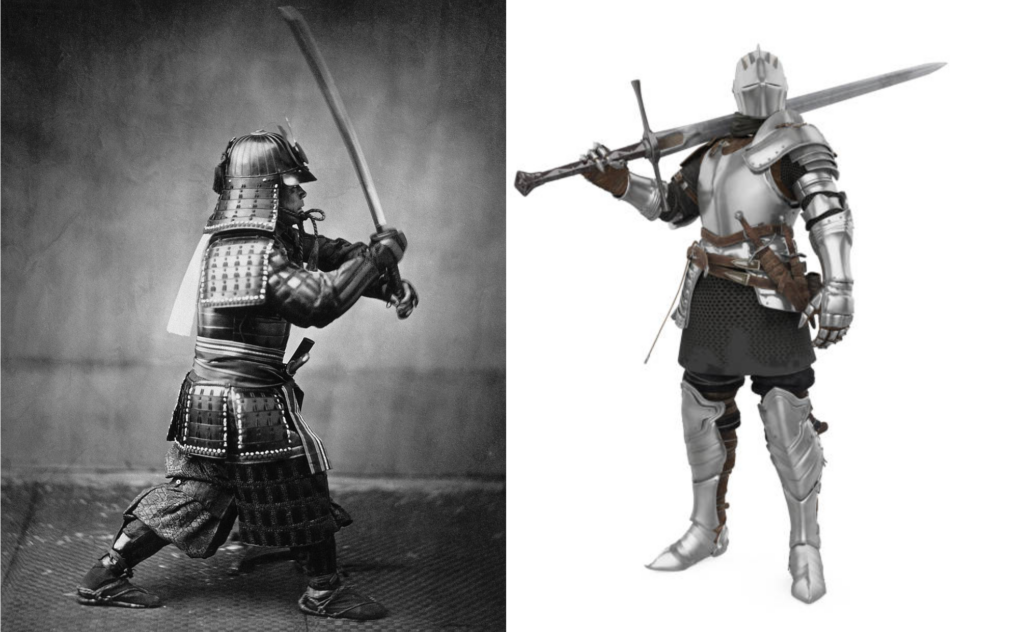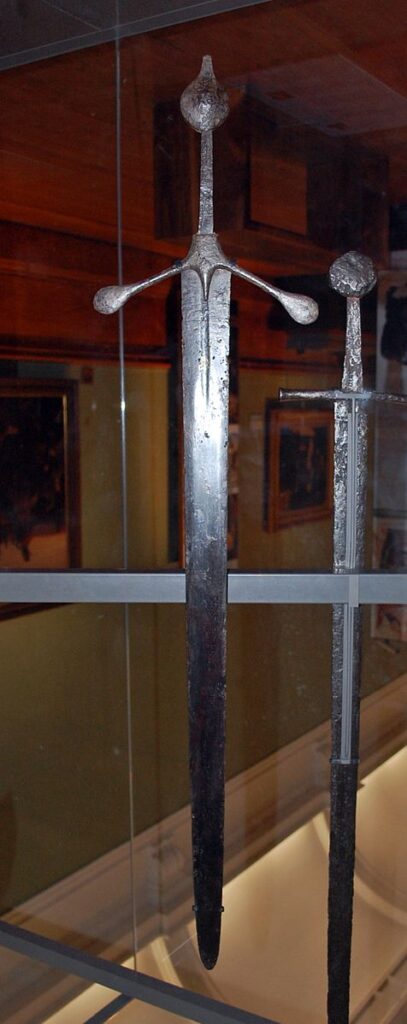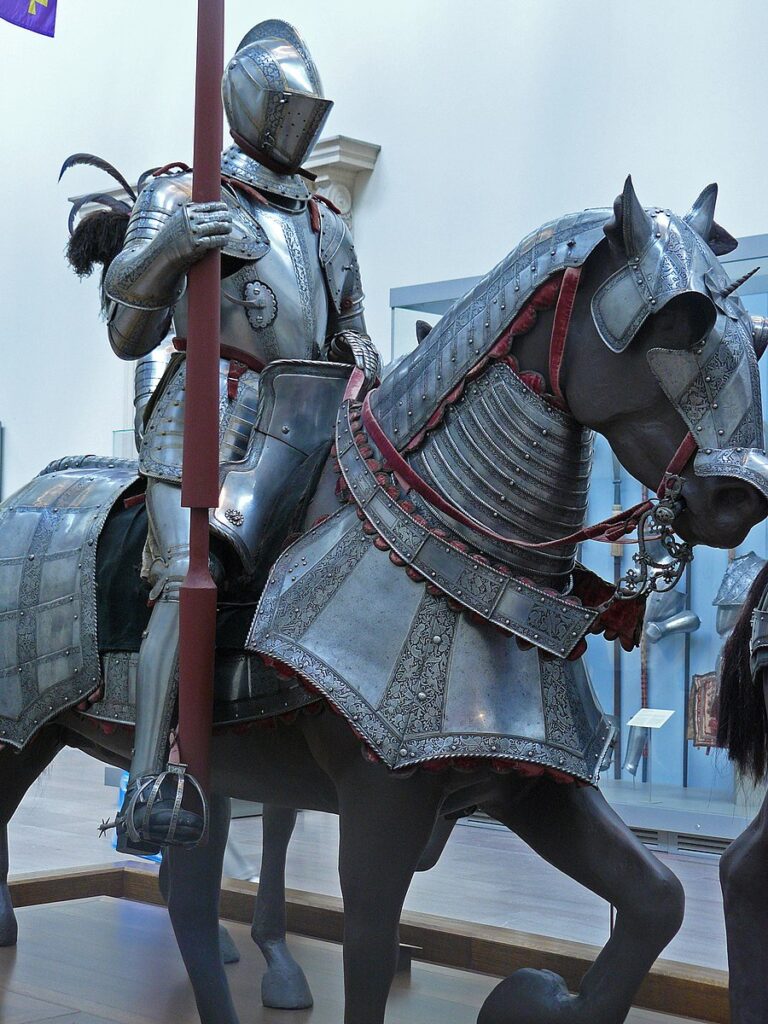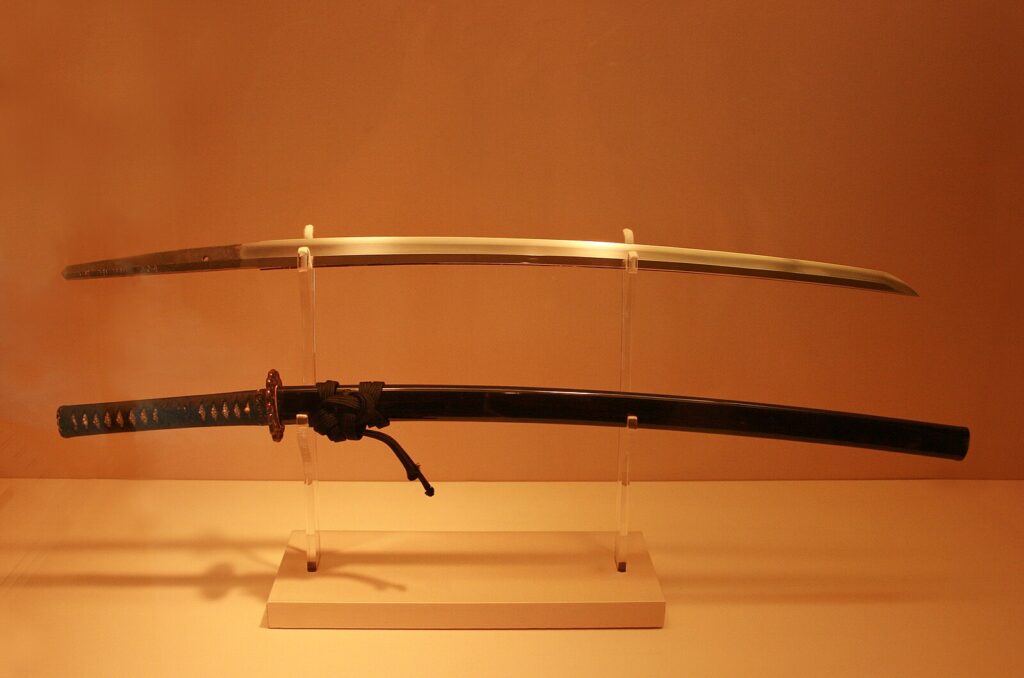In two different parts of the world, two different types of warriors took up swords. They have cemented themselves in history as some of the most skilled fighters of all time. The legends of knights and samurais are so incredible that they almost seem more like parts of myths instead of reality.
But knights and samurais were both very real. While they likely never crossed paths, their similar statuses have drawn some comparisons.
Knights and samurais were both specialized warriors who fought with swords and did so for the glory of their leaders. So, head to head, knights vs samurai, who would win?

Medieval Knights and Japanese Samurai: Similarities and Differences
To determine who would win in a fight between knights and samurais, we first need a quick overview of both.
Medieval Knights
- Existed: 500-1500 CE
- Weapons: Long swords, lances, maces, battle axes
- Armor: Plate armor
Knights existed during the Middle Ages, also known as the Dark Ages. Typically, they were members of the nobility and were highly trained, not just at battle but also at horseback riding and other court necessities.
Certain rules of etiquette bound knights. They also participated in forms of entertainment such as jousts.

Japanese Samurai
- Existed: 1185-1868 CE
- Weapons: Katana, Naginata, Yumi longbow
- Armor: Early armor consisted of kozane, or scale armor. Later armor consisted of ito-momo or iron plate armor.
The Japanese samurai were members of a military caste. As such, they adhered to a strict code known as bushido. Samurai translates to “one who serves.” Similarly, bushido translates to “the way of the warrior.”
Honor was incredibly important to the samurai. They were very strict about the ways in which they engaged in battle as well as their actions in day-to-day life. Samurai served daimyos, or Japanese great lords, and were notoriously loyal, even to the point of death.
Knights Vs Samurai: Who Would Win?
Now that we know a little more about knights and samurais, it’s time to determine which one would win in battle.
First, let’s look at the advantages that each warrior has. Both knights and samurais were trained from a young age and their training was intense. Each would come out of the other side deadly and strong. As far as their training goes, they are rather evenly matched.
Armor and Defense
In full armor, the knight would have the advantage in defense. The heavy plate armor would be all but impenetrable by a samurai’s katana or arrows.

A samurai would also wear armor, but their armor was lighter. It was constructed from scales created from either iron or leather. It was arranged in such a way as to ascertain that a samurai wouldn’t lose their speed.
Samurai armor was protective. But since it was crafted to favor freedom of movement over being impenetrable, it would leave a samurai more vulnerable to direct strikes by a knight.
Winner: Knight
Speed and Agility
A knight’s plate armor becomes a problem when speed is involved. It may protect them from heavy sword strikes and hails of arrows, but a knight’s armor was incredibly heavy.
It could weigh anywhere between 60 and 80 pounds (30-25 kilograms). This would be heavy enough to slow down even the strongest knight.
Add in the weight of a knight’s weapons, and they become significantly slower than a samurai. A samurai’s lightweight armor and their focus on the speed of their katana strikes would make them deadly against an unarmored knight. However, if their opponent was in full plate armor, a samurai would have a difficult time getting a hit in.
This is where the samurai speed would also come in handy. Even a knight’s armor would have a few weak points, specifically the neck and joints.
Samurai were known for the precision of their strikes. This could lead to them getting a deadly neck strike or debilitating joint strike on a knight before they even knew what was happening.
Winner: Samurai
Offense and Strength
To fairly compare a knight and a samurai, we’ll assume they are both fighting with their trademark swords–a longsword for the knight and a katana for the samurai.
Because of the weight a knight carries, their style of sword fighting would favor stronger, more powerful hits. These would ultimately end up being slower but more debilitating.
A longsword carried by a knight would be a premium blade for the time. But it’s unlikely that even the best longsword could be as sharp as the meticulously crafted katana.

Longswords are double-sided blades compared to the katana’s single side. This is negated by the samurai’s way of fighting with the katana. Neither sword comes out superior to the other, so it all comes down to the warrior’s skill with their particular blade.
Both knights and samurais were trained for both one-on-one duels as well as full-scale battles. Against one another, they would be pretty even.
The knight may have the advantage of sheer strength after years of training and fighting in full-plate armor. In a head-to-head battle of strength, we can assume the knight would come out on top.
But we can’t simply give this category to the knight, because offense isn’t only about strength. The intense training of the samurai and the deadly precision of their fighting style could make up for being less physically powerful than a knight, which leaves this category unknown.
Winner: Tie
Knights Vs Samurai: In Conclusion
After our investigation, it has been determined that the winner of a knights vs samurai battle is inconclusive. There are too many variables in a fight like this. Even one simple change could turn the tides of battle in either direction.
In an unarmored battle, it seems that the samurai would be the winner. A samurai would be faster and more agile than a knight, and this would give them the upper hand.
In a battle in full armor, a knight would likely take the win. There is the possibility that a samurai’s speed may help them strike a knight’s weak areas. But a knight’s plate armor is nearly impenetrable and would keep them safe from the majority of a samurai’s attacks.
The only thing that we know for sure is that both of these warriors were incredible fighters and that their legends have carried through history long after they were gone.
References
“The Weapons of an English Medieval Knight”
https://www.worldhistory.org/article/1238/the-weapons-of-an-english-medieval-knight/
“Samurai armour”

